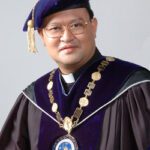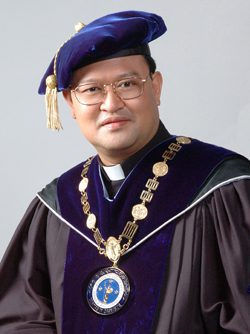 For the fourth consecutive year, Fr. Bañaga, CM—who is also a photographer since his youth—mounted a photo exhibit entitled, In the Footsteps of St. Vincent de Paul. The show features his photographs from different places in France where St. Vincent spent his life and works. It is currently on view at the Adamson University Gallery until October 26.
For the fourth consecutive year, Fr. Bañaga, CM—who is also a photographer since his youth—mounted a photo exhibit entitled, In the Footsteps of St. Vincent de Paul. The show features his photographs from different places in France where St. Vincent spent his life and works. It is currently on view at the Adamson University Gallery until October 26.
Opens exhibit in Adamson gallery
Every year, the Adamson University is one with the Vincentian family all over the world in celebrating the Feast Day of St. Vincent de Paul on September 27. Leading the university’s tribute to its patron saint during the Vincentian month is no less than its president, Fr. Gregg Bañaga Jr., CM.
“St. Vincent is considered the patron of the poor, and also the universal patron of all charitable associations because of the work that he did during his time. We at Adamson celebrate his Feast Day every September 27 of the year, together with the Vincentian family from three associations that St. Vincent founded: the Ladies of Charity, the Congregation of the Mission, and the Daughters of Charity,” said Fr. Bañaga in an interview with The Sunday Times Magazine.
So for the fourth consecutive year, Fr. Bañaga—who is also a photographer since his youth—mounted a photo exhibit entitled, In the Footsteps of St. Vincent de Paul. The show features his photographs from different places in France where St. Vincent spent his life and works. It is currently on view at the Adamson University Gallery until October 26.

Besides his photos, the exhibit also carries some works by Fr. Manny Manimtim, CM, a fellow Filipino Vincentian priest based in Congregation of the Mission (CM) motherhouse in Paris.
Fr. Bañaga recalled that his photographs were taken in June and July 2008 when he stayed at the motherhouse of CM called the Maison Mere for a three-week seminar. It was during this time that he had the opportunity to visit the so-called “Vincentian places” all over France. It was Fr. Manimtim who accompanied him.
In taking the photographs, Fr. Bañaga had one thing in mind: “I will bring home and show the photos to the members of the Adamson community,” he said.
He added, “The exhibit is one way our students will get to know more about St. Vincent. They will see the original places where he lived and worked that are still very much preserved. Also, some aspects of his life can be seen depicted in the stained windows from the churches.”
‘Walking in his footsteps’
Fr. Bañaga also shared his personal experience when he visited and shot the Vincentian places. He explained, “It was like a pilgrimage of the heart. I wanted to really go to those places where he lived and worked for my own spiritual conversion. For my own spiritual upliftment. And it was very really touching and moving. I even said Mass in the crib he was born that they have made into an altar. It was really like walking in the footsteps of St. Vincent.”
The birthplace Fr. Bañaga was referring to is Berceau located in the city of Dax in Southern France, near the Pyrannes Mountains, almost at the border of Spain. “You know, that place was originally called Ranquines. However, the people decided to change the name Berceau, meaning birthplace, of course in honor of St. Vincent,” Fr. Bañaga continued his story.
Other places included in the exhibit are Parish Church of Pouy where St. Vincent was baptized; the house of Monsieur de Comet, the young Vincent’s benefactor who sent him to school in exchange for tutoring his sons, as well as the school where he studied, both in Dax; the Parish Church of Clichy where he became a most beloved pastor; the church of Chateau L’Eveque where he was ordained; and Gannes and Folleville, estates owned by the Di Gondi family, where he organized priests to preach tenants (these “missions” led to the foundation of the Congregation of the Mission), among others.
A series of stained glass depicting the lifetime of St. Vincent, from his birth until death, are also displayed at the gallery.
But the true highlight of the exhibit is the wax-covered body of St. Vincent kept and preserved at the chapel of the Maison Mere.
“According to historians, St. Vincent’s body lay incorrupt for more than 70 years after he died. When his coffin was opened for beatification, the body was sealed again. However, water seeped into his remains. When the coffin was opened again for his canonization they found that the body had shriveled. So they decided to put wax over it,” Fr. Bañaga explained.
“Today, the body looks exactly of St. Vincent’s. It is encased and preserved in a silver glass coffin. But you cannot touch it. The chapel is open daily for pilgrims and devotees to pray and pay tribute,” he continued.
However, it is interesting to note that though St. Vincent’s body lies with the Vincentian fathers, his heart stays with the Vincentian sisters. It is displayed at the Chapel of the Miraculous Medal, just 10 minutes away from Maison Mere.
“The story of that was, during the French Revolution, St. Vincent’s heart was removed from his body. It was hidden inside a Bible and shipped to the Daughters of Charity in Italy. After the revolution, the sisters didn’t want to return the heart to the priests anymore,” Fr. Bañaga revealed.
Through his travels, Fr. Bañaga saw that practically all churches and chapels around France have statues and stained glasses of St. Vincent. From this he realized, “St. Vincent is really venerated and well-loved by the people of France.”
Tags: Adamson University (Philippines)


It would be lovely to be able to see some of the photographs. Any idea if they will be online anywhere?
Great question! They were not on their website yet. Perhaps because the exhibit is not yet open.
Sources tell me the exhibit is expected to be online sometime next week. Famvin will soon have access to the powerpoint of Fr. Greg Gay’s recent visit to the Philippines.